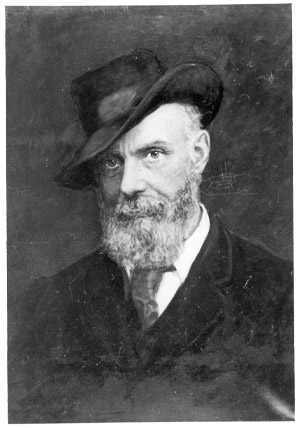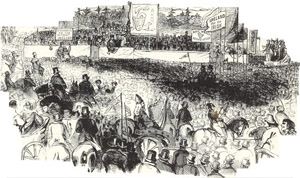ON THIS DAY
Published in Issue 4 (July/August 2022), News, Volume 30BY AODHÁN CREALEY
JULY

Above: John George Adair, owner until his death in 1885 of the Glenveagh estate, which became a National Park in 1984. (Panhandle Plains Historical Museum, Texas)
15/1984
Glenveagh National Park in north-west Donegal, covering 40,000 acres, was formally opened by President Patrick Hillery. The estate was created (1857–9) by businessman John George Adair, who also built Glenveagh Castle (1870) and is remembered today for the Derryveagh evictions (1861), when he ejected 244 of his tenants. Adair died in 1885, after which the castle fell into disrepair. Later, during the Civil War, the castle and grounds were occupied for a time by anti-Treaty forces who used it as their headquarters, and it narrowly avoided being amongst the c. 300 ‘big houses’ destroyed during that period. When the Irregulars eventually moved out, Peadar O’Donnell was told to burn it to the ground. He ignored the order. In 1929 the estate was purchased by an American academic, Professor Arthur Kingsley Porter, who disappeared, presumed drowned, four years later after spending the night in his fisherman’s hut on Inishbofin Island. The last private owner was the Philadelphia art collector and philanthropist Henry McIlhenny, whose grandfather had emigrated from nearby Carrigart during the Great Famine. He sold the lands to the State in 1975 and donated the castle and gardens six years later. All three were generous hosts. Amongst Adair’s visitors were, no doubt, his influential relations from the business and banking world, whilst the polymath George William Russell (‘AE’), equipped with his paints, regularly stayed with Kingsley Porter. McIlhenny, who spent his summers in Ireland, kept an open house there. Besides celebrities like Greta Garbo, Marilyn Monroe and Clark Gable, he hosted the great American composer Samuel Barber (1910–81), who had Scots/Irish ancestry, during the summer of 1952. Barber would be best remembered today for his mournful Adagio for Strings (1936).
05/1922
Cathal Brugha (47), on the last day of fighting between the National Army and anti-Treaty IRA in O’Connell Street, emerged from the Hammam Hotel with guns blazing and was mortally wounded. He died two days later.
06/1997
Citing the threat to Catholic civilians by loyalist paramilitaries, the RUC Chief Constable permitted c. 1,200 Orangemen to march along the Garvaghy Road in Portadown, the last time they were allowed to do so.
07/1972
Secretary of State William Whitelaw met the IRA leadership, including Seán Mac Stiofáin, Martin McGuinness and Gerry Adams, for talks in London.
09/1972
Gun battles raged throughout West Belfast following the breakdown of an IRA ceasefire. Five people were shot dead by the Parachute Regiment in the Springhill area, including a thirteen-year-old girl and a Catholic priest.
12/1922
The Provisional Government appointed a War Council, with Michael Collins as commander-in-chief and Richard Mulcahy as chief-of-staff and minister for defence.
18/1972
James Jones (18), a member of the King’s Own Regiment from Kirby, Liverpool, was shot dead by an IRA sniper at a sentry post in West Belfast. He became the 100th British soldier to die on active service in Northern Ireland since 1969.
21/1972
In what became known as ‘Bloody Friday’, nine were killed-seven civilians, including a fourteen-year-old schoolboy, and two soldiers-and 130 others injured, when the IRA detonated twenty devices in 65 minutes.
31/1972
‘Operation Motorman’, the biggest British military operation since the Suez crisis (1956), re-established a military presence in the ‘no-go areas’ of Derry and Belfast. Three large car bombs exploded in the village of Claudy, 10km (6 miles) south-east of the city, killing or mortally wounding six civilians.
AUGUST

Above: : The procession in the foreground and platform in the background at Daniel O’Connell’s ‘monster meeting’ at the Hill of Tara on 15 August 1843.
15/1843
The biggest of Daniel O’Connell’s ‘monster meetings’, as the London Times described them, in support of Repeal of the Act of Union took place on the Hill of Tara. From the middle of March over 30 such gatherings, attended by hundreds of thousands, took place usually at historic sites in the three southern provinces—gatherings not seen again until the visit of Pope John Paul II in 1979. The day-long—sometimes two-day—proceedings would begin with a huge procession of bands in uniform, floats, carriages and carts, followed by thousands on horseback or on foot, which would proceed to a makeshift platform. Here would sit newspaper reporters, local dignitaries or anyone else prepared to pay a shilling to hear O’Connell at close quarters. The Liberator would then deliver his trademark bellicose speech on the virtues of Repeal, backed up by threats such as parliamentary secession and the setting up of an alternative courts system. Afterwards an evening banquet for O’Connell and a few hundred paying guests would take place in a large hall or specially built pavilion. An estimated 900,000 attended Tara, as described by Lecky:
‘O’Connell, standing by the stone where the Kings of Ireland were once crowned, sketched the coming glories of his country. Beneath him, like a mighty sea, extended the throng of listeners. They were so numerous that thousands were unable to catch the faintest echo of the voice they loved so well; yet all remained passive, tranquil and decorous. In no instance did these meetings degenerate into mobs. They were assembled, and they were dispersed, without disorder or tumult; they were disgraced by no drunkenness, by no crime, by no excess …’
01/1932
Dr Pat O’Callaghan won his second Olympic gold medal at the Los Angeles Olympics in the hammer event. Bob Tisdal won gold in the 400m hurdles.
06/1972
Idi Amin, dictator of Uganda, announced that 50,000 Asians with British passports were to be expelled from the country to the UK within the next three months, as they were ‘sabotaging the Ugandan economy’.
07/1972
The shooting of librarian and member of the UDR Lance-Corporal Henry Creighton (27) by the IRA near his home on the Fermanagh/Monaghan border brought the death-toll in Northern Ireland since 1969 to 500.
11/1932
Dr Thomas E. O’Higgins was elected president of the Army Comrades’ Association, later to be known as the Blueshirts. Membership was opened to the public and claimed to be 30,000.
12/1922
Arthur Griffith (51), president of Dáil Éireann, died from a brain haemorrhage. He was the first Irish leader to be buried as a head of state.
14/1922
Alfred Harmsworth, Lord Northcliffe (57), newspaper and publishing magnate who was born in Chapelizod, Co. Dublin, and was an early promoter of popular journalism, died.
16/1962
Frank Gallagher (69), journalist, author and republican, who was the first editor of the Irish Press (1931–5), died.
17/1922
Dublin Castle was handed over to the Civic Guard, later the Garda Síochána, after the departure of the last British troops.
22/1922
Michael Collins (31), commander-in-chief of the National Army, was killed in an engagement with the IRA at Béal na Bláth, near Macroom, Co. Cork.
22/1972
Nine people were killed—three members of the IRA, two lorry drivers and four customs officials—when a 50lb IRA bomb exploded prematurely at a custom clearing station at Newry, Co. Down.
23/1972
Lord Killanin became the first Irishman to be elected president of the International Olympics Commission.
















